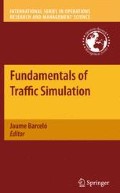Abstract
After two decades of academic research the microscopic, behavior-based multi-purpose traffic flow simulator VISSIM had been introduced in 1994 to analyze and optimize traffic flows. It offers a wide variety of urban and highway applications, integrating public and private transportation. A large part of this chapter is devoted to modeling principles of VISSIM, core traffic flow models consisting of longitudinal and lateral movements of vehicles on multilane streets, a conflict resolution model at areas with overlapping trajectories, dynamic assignment and the social force model applied to pedestrians. Techniques to calibrate the core traffic flow models are discussed briefly.
Access this chapter
Tax calculation will be finalised at checkout
Purchases are for personal use only
References
Benz Th (1985) Mikroskopische Simulation von Energieverbrauch und Abgasemission im Straßenverkehr. Schriftenreihe des Instituts für Verkehrswesen Heft 32, Universität Karlsruhe
Brannolte U (1980) Verkehrsablauf auf Steigungsstrecken von Richtungsfahrbahnen. Forschung Straßenbau und Straßenverkehrstechnik, Heft 318, Bonn
Busch F, Leutzbach W (1983) Spurwechselvorgänge auf dreispurigen BAB-Richtungsfahrbahnen. Auftrag des Bundesministerium für Verkehr, Institut für Verkehrswesen, Universität Karlsruhe
Cascetta E, Nuzzolo A, Russo F, Vitetta A (1996) A modified logit route choice model overcoming path overlapping problems: specification and some calibration results for interurban networks. In: Lesort JB (ed) Transportation and traffic theory. Proceedings from the thirteenth international symposium on transportation and traffic theory, Lyon, France. Pergamon Press, Oxford, pp 697–711
Falkenberg G, Vortisch P (2003) Bemessung von Radverkehrsanlagen unter verkehrstechnischen Gesichtspunkten. Wirtschaftsverlag N.W. Verlag für Neue Wissenschaft, ISBN-13 978-3897019690; Bremerhafen, Germany, 2003
Fellendorf M (1994) VISSIM: Ein Instrument zur Beurteilung verkehrsabhängiger Steuerungen (VISSIM: a tool to analyse vehicle actuated signal control), In: Verkehrsabhängige Steuerungenam Knotenpunkt edited by the German Research Foundation for transport and roads (FGSV), Kassel, p 31–38
Haas M (1985) LAERM Mikroskopisches Model zur Berechnung des Straßenverkehrslärms. Schriftenreihe des Instituts für Verkehrswesen Heft 29, Universität Karlsruhe
Helbing D, Molnár P (1995) Social force model for pedestrian dynamics. Phys Rev E 51(5):4282–4286
Hausberger S (2003) Simulation of real world vehicle exhaust emissions, VKM-THD Mitteilungen, Heft/vol 82, Graz
Hirschmann K, Fellendorf M (2009) Emission minimizing traffic control – simulation and measurements. Proceedings of mobil.TUM 2009, International scientific conference on mobility and transport, TU München
Hossain MJ (2004) Calibration of the microscopic traffic flow simulation model VISSIM for urban conditions in Dhaka city. Master thesis, University of Karlsruhe, Germany
Hubschneider H (1983) Mikroskopisches Simulations system für Individualverkehr und Öffentlichen Personennahverkehr. Schriftenreihe des Instituts für Verkehrswesen Heft 26, Universität Karlsruhe
Kovali V, Alexiadis V, Zhang L (2007) Video-based vehicle trajectory data collection. Proceedings of the 86th annual meeting of the TRB, Washington, USA, 2007
Kretz T, Hengst S, Vortisch P (2008) Pedestrian flow at bottlenecks – validation and calibration of Vissim’s social force model of pedestrian traffic and its empirical foundations. International symposium of transport simulation 2008 (ISTS08), Gold Coast, Australia, 2008
Matsuhashi N, Hyodo T, Takahashi Y (2005) Image processing analysis on motorcycle oriented mixed traffic flow in Vietnam. Proceedings of Eastern Asia society for transportation studies (EAST), vol 5, Tokyo, pp 929–944
Menneni S, Sun C, Vortisch P (2008) Microsimulation calibration using speed-flow relationships. Transportation research board, vol 2088. Washington pp 1–9
Menneni S, Sun C, Vortisch P (2009) Integrated microscopic and macroscopic calibration for psychophysical car-following models. TRB 88th annual meeting compendium of papers DVD, Washington, 2009
Michaelis RM (1963) Perceptual Factors in Car Following. Proceedings from the Second International Symposium on Transportation and Traffic Theory, OECD, Paris, 1965
Reiter U (1994) Empirical studies as basis for traffic flow models. In: Akcelik R (ed) Proceedings of the Second International Symposium on Highway Capacity, vol. 2. Sydney, pp 493–502, ISBN 0869106406
Sparmann U (1978) Spurwechselvorgänge auf zweispurigen BAB-Richtungsfahrbahnen. Forschung Straßenbau und Straßenverkehrstechnik, Heft 263, Bonn
Wiedemann R (1974) Simulation des Strassenverkehrsflusses. Schriftenreihe des Instituts für Verkehrswesen Heft 8, Universität Karlsruhe
Wiedemann R, Reiter U (1992) Microscopic traffic simulation: the simulation system MISSION, background and actual state. In: CEC project ICARUS (V1052) final report, vol 2, Appendix A. Brussels, CEC
Wiedemann R, Schnittger St (1990) Einfluß von Sicherheitsanforderungen auf die Leistungsfähigkeit im Straßenverkehr (Richtungsfahrbahnen). Forschung Straßenbau und Straßenverkehrstechnik, Heft 586, Bonn
Winzer, Th (1980) Messung von Beschleunigungsverteilungen. Forschung Straßenbau und Straßenverkehrstechnik, Heft 319, Bonn
Author information
Authors and Affiliations
Corresponding author
Editor information
Editors and Affiliations
Rights and permissions
Copyright information
© 2010 Springer Science+Business Media, LLC
About this chapter
Cite this chapter
Fellendorf, M., Vortisch, P. (2010). Microscopic Traffic Flow Simulator VISSIM. In: Barceló, J. (eds) Fundamentals of Traffic Simulation. International Series in Operations Research & Management Science, vol 145. Springer, New York, NY. https://doi.org/10.1007/978-1-4419-6142-6_2
Download citation
DOI: https://doi.org/10.1007/978-1-4419-6142-6_2
Published:
Publisher Name: Springer, New York, NY
Print ISBN: 978-1-4419-6141-9
Online ISBN: 978-1-4419-6142-6
eBook Packages: Business and EconomicsBusiness and Management (R0)

